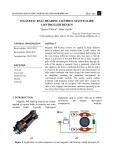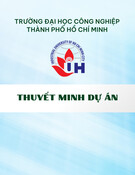
TNU Journal of Science and Technology
229(10): 399 - 406
http://jst.tnu.edu.vn 399 Email: jst@tnu.edu.vn
FAST INTEGRAL TERMINAL SLIDING MODE CONTROL FOR AN
UNDERACTUATED QUADROTOR WITH THE EXTERNAL DISTURBANCE
AND INPUT SIGNAL DELAY
Dang Ngoc Trung*, Duong Quynh Nga
TNU - University of Technology
ARTICLE INFO
ABSTRACT
Received:
04/6/2024
This paper is invested to study trajectory tracking problem for Quadrotor
unmanned aerial vehicle (UAV) subject to the external disturbance and
input time delay. In this study, the Quadrotor with six degrees of freedom
is considered as a highly nonlinear system, based on the Euler-Newton
formulation, a math model of Quadrotor consists of translational and
rotational systems is given. According to Pade approximation, a study is
given about reducing time input delay. Then, a new robust control based
on Integral Fast Terminal Sliding Mode Control (IFTSM) algorithm is
proposed for both translational and rotational systems of quadrotor. The
IFTSM control law: (i.) fast convergence errors; (ii.) chattering
reduction; (iii.) to address the external disturbance and input time delay
by its robustness. In addition, using the Lyapunov stability theory, the
stability of the close- loop quadrotor system is guaranteed. Finally, a
simulation built in MATLAB is given to prove the effectiveness of the
proposed control law.
Revised:
10/7/2024
Published:
11/7/2024
KEYWORDS
Quadrotor
Unmanned Aerial Vehicles
Robust control
Integral Fast Terminal Sliding
Mode (IFTSM) Control
Input Time Delay
ĐIỀU KHIỂN TRƢỢT TÁC ĐỘNG NHANH
CHO HỆ QUADROTOR THIẾU CƠ CẤU CHẤP HÀNH
DƢỚI ẢNH HƢỞNG CỦA NHIỄU VÀ TRỄ TÍN HIỆU ĐẦU VÀO
Đặng Ngọc Trung*, Dƣơng Quỳnh Nga
Trường Đại học Kỹ thuật Công nghiệp – ĐH Thái Nguyên
THÔNG TIN BÀI BÁO
TÓM TẮT
Ngày nhận bài:
04/6/2024
Bài viết là công trình nghiên cứu về vấn đề bám quỹ đạo của Quadrotor
dưới sự xem xét ảnh hưởng của nhiễu loạn bên ngoài và trễ tín hiệu đầu
vào. Mỗi Quadrotor được xem xét gồm 6 bậc tự do, bằng sử dụng định
luật Euler-Newton, một mô hình động học của Quadrotor được đưa ra
gồm 2 hệ thống con: hệ tịnh tiến và hệ chuyển động quay. Theo xấp xỉ
Pade, một nghiên cứu về giảm thiểu ảnh hưởng của trễ tín hiệu đầu vào
được đề cập trong bài báo. Tiếp đó, một bộ điều khiển trượt tác động
nhanh bền vững được thiết kế cho cả 2 hệ thống con. Với luật điều
khiển được đề xuất sẽ đảm bảo: i. Thời gian hội tụ sai lệch nhanh, ii.
Giảm hiện tượng chaterring, iii. Xử lý vấn đề nhiễu và trễ tín hiệu đầu
vào bằng tính bền vững trong luật điều khiển. Thêm vào đó, bằng sử
dụng Lý thuyết ổn định Lyapunov, sự ổn định của hệ thống sẽ được
chứng minh và đảm bảo. Cuối cùng, một mô phỏng được xây dựng trên
phần mềm Matlab được đưa ra để kiểm chứng sự hiệu quả của phương
án đề xuất.
Ngày hoàn thiện:
10/7/2024
Ngày đăng:
11/7/2024
TỪ KHÓA
Máy bay không người lái bốn
cánh
Thiết bị bay không người lái
Điều khiển bền vững
Điều khiển trượt tác động
nhanh bền vững
Trễ thời gian đầu vào
DOI: https://doi.org/10.34238/tnu-jst.10534
* Corresponding author. Email: trungcsktd@tnut.edu.vn

TNU Journal of Science and Technology
229(10): 399 - 406
http://jst.tnu.edu.vn 400 Email: jst@tnu.edu.vn
1. Introduction
In recent years, unmanned aerial vehicles (UAVs) have garnered significant attention within
the research community due to their vast potential applications in numerous tasks and fields
where human presence may be challenging to attain. These applications include disaster
assessment, wildfire detection, agricultural applications, and more. Quadrotor of the typical types
of unmanned aerial vehicles which has been increasingly popular due to its capability of taking
off and landing vertically, maintaining position stability, and flexible trajectory. Consequently,
one of the common and significant challenges posed is the problem of control for quadrotors.
This is a non-trivial problem due to the quadrotor's 6 degrees of freedom with 4 control inputs.
Furthermore, in practical problems and applications, accurately knowing the object model is
often difficult to achieve, coupled with frequent model uncertainties. Therefore, addressing
model uncertainties is a crucial requirement in designing control systems for quadrotors.
In numerous previous studies, various control structures have been proposed to achieve good
control quality, including PID controllers [1], [2], LQR controllers [3], backstepping controllers
[4], [5] and sliding mode controllers [6]-[8]. In recent works [6]-[12], the nonlinear quadrotor is
studied; by using Euler- Lagrange principle, a math mode of quadrotor is given with two
subsystems (translational subsystem and rotational subsystem). In [8], an adaptive backstepping
fast terminal sliding mode control (ABFTSMC) is developed to track a desired trajectory of a
6DOF quadrotor attitude and position in the finite- time. Additionally, many observer-based
methods [9]- [11] are employed to compensate for dynamic model inaccuracies of the ideal
quadrotor model, followed by the design of a nonlinear feedback controller to address the
tracking control problem.
In practical engineering applications, input time delay usually exists and is a result of the low
of performance. To eliminate the influence of input time delay, in this work in [13] the adaptive
control approach was employed for the SISO high-order nonlinear systems. Based on Lyapunov–
Krasinski theory, a robust compensator was proposed to address the unknown fixed time delay
[9]. In the work [11], the input time delay is studied for quadrotor system, where, by using Pade
approximation, the small-time delay can be eliminated.
In this work, a robust controller for a quadrotor UAV for both position and attitude is developed.
The main goal of the paper is to track the position of quadrotor UAV to the desired reference
trajectory under the external disturbance, wind gust and input time delay. The stability of closed
loop of the quadrotor system and the global convergence of the position and attitude tracking errors
are proof by the Lyapunov stability theory. Inspired by the work in [11], by using Pade
approximation and Laplace transform, the time input delay can be eliminated. Then, a new robust
control based on Integral Fast Terminal Sliding Mode Control (IFTSM) algorithm is proposed for
both translational and rotational systems of quadrotor. The main contribution of the paper.
i) By using the new IFTSMC algorithm, the position and attitude tracking errors of quadrotor
convergence to zero asymptotically in the fast finite- time.
ii) By the strong robustness of the proposed control law, the external disturbance and input
time delay of quadrotor system can be eliminated.
iii) By using integral component in the sliding surface and tanh(x) function in the switching
control, the chattering is reduction.
This paper is organized as follows. Section 2 presents the dynamic model of quadrotor and the
control problem. Then, the proposed position and attitude control schemes based IFTSM
algorithm, and the stability analysis of the closed- loop system is given to achieve path tracking.
In Section 3, a simulation result is given to verify the proposed control law. Section 4 concludes
the paper.

TNU Journal of Science and Technology
229(10): 399 - 406
http://jst.tnu.edu.vn 401 Email: jst@tnu.edu.vn
2. Problem formulation and control design
2.1. Problem formulation
2.1.1. Dynamic model of quadrotor
The configuration of quadrotor UAV is described
by Figure 1 in [8]. This system is a rigid body with
four rotors and six degrees of freedoms following three
directions
,,x y z
and three motion
,,
.
Because of four inputs while six output, the system is
underactuated and unstable [2]. Besides, in this paper,
the quadrotor is considered under some assumptions as
following as
i. The quadrotor is rigid body, so the dynamic
model of quadrotor can be analyzed by the Euler-
Newton formulation [14].
ii. The desired forces and moments to control
the attitude motion of quadrotors can be generated
by the four rotors [10], [15].
Figure 1. The quadrotor UAV [8]
Let
B B B
B = x , y ,z
donates the body fixed frame,
E E E
E = x , y ,z
donates the earth fixed inertial
frame. Let
= , ,p x y z
represent the position of quadrotor in the earth fixed inertial frame,
= , ,
represent the Euler angle (roll angle Φ, pitch angle θ, and yaw angles ψ), satisfy that:
ππ
- < <
22
and
ππ
- < <
22
. Although the behavior of quadrotor is described in the body fixed frame,
the position of quadrotor is described in the earth fixed inertial frame. So, it needs a rotation matrix
[8] which transfers the coordinates from the body fixed frame to the earth fixed inertial frame.
=
c c s s s s c c c c s s
c s s s s c s c s s s c
s s c c c
B2E
R
(1)
With
i
S = sin(i)
and
i
C = cos(i)
. Based on the Euler-Lagrange formulation, following the
work in [8], the translational dynamic and rotational dynamic of quadrotor is given:
2
2
2
1
1
1
1
1
1
x
Tx
y
Ty
z
Tz
r
r
K
x x c c s s s U d
mm
K
y y c s s s c U d
mm
K
z z c c U g d
mm
J J J w K U d
J
J J J w K U d
J
J J K U d
J
(2)
Where
4 3 2 1
w=Ω + Ω - Ω - Ω
(Ωi (i = 1,2,3,4) are the speed of rotors), Jr is the rotor inertia,
, , , , ,
i
d i x y z
donate the external disturbance,
,,J J J
represent the rotary inertia respect

TNU Journal of Science and Technology
229(10): 399 - 406
http://jst.tnu.edu.vn 402 Email: jst@tnu.edu.vn
to x-axes, y-axes, and z-axes, respectively. The UT and
,,U U U
are the desired control forces
following as:
2222
1 2 3 4
22
42
22
31
2 2 2 2
1 2 3 4
Tt
tt
tt
w
Uk
U k l
U k l
Uk
(3)
With kt, kw are quadrotor parameter, lt is the distance from the center mass of quadrotor to rotor.
Remark 1. The behavior of quadrotor UAV is considered under influence of atmosphere, in
where
= , ,
i
K i x y z
are the translation drag coefficient, and
= , ,
i
Ki
are aerodynamic
friction coefficients.
Remark 2. The external disturbance
, , , , ,
i
d i x y z
are unknown, but they are assumed
that
,
ii
dd
are bounced.
So that the convenience of control design, the dynamic model of quadrotor is rewritten following as:
1
p
pp
K
p p u d
m
f J d
(4)
Where
,,
p x y z
K diag K K K
is drag matrix,
,,J diag J J J
donates the inertia matrix,
3
fR
is nonlinear function vector,
,, T
p x y z
d d d d
and
,, T
d d d d
are external
disturbance vectors.
0
10
px
p py
pz
u c c s s s
u u c c s s c
m
u c c g
u
u
u
(5)
2.1.2. Input time delay
In practical engineering applications, input time delay usually exists and is a result of the low
of performance. That is to say, the input time delay can be written as
()ut
in which τ is time
delay. To track the work of [16], based on Laplace transform and Pade approximation, with small
time delay, the input time delay can be solved by:
42
u t u t
ut
(6)
Where
is intermediate variable.
Remark 3. Although the intermediate variable
is not real state of system, it can be viewed
as an error variable that needs to be addressed. This means that the problem of input delay will
be eliminated.
Remark 4. To apply this work to quadrotor, in the study [11], the input time delay can be
eliminated by a robustness control scheme.

TNU Journal of Science and Technology
229(10): 399 - 406
http://jst.tnu.edu.vn 403 Email: jst@tnu.edu.vn
2.1.3. Integral fast terminal sliding mode control
The traditional fast terminal sliding mode (FTSM) control [17] is followed by.
s x x x sign x
(7)
where s is sliding surface,
01
, α and β are positive constant. When s = 0, in result in
x x x sign x
, which will reach
0x
in the fast finite time. But, using sign in the
sliding surface which is result of high chartering. To address this problem, in this paper, a new
integral fast terminal sliding mode (IFTSM) control is proposed which is following by.
0
t
s x x x sign x d
(8)
With the new integral fast terminal sliding mode (IFTSM) control proposed, the chattering
problem is reduced.
2.2. Control design
This section is devoted to designing a controller for the quadrotor system. The control
objective of the paper is to track the position of quadrotor UAV to the desired reference trajectory
under the external disturbance, wind gust and input time delay. To achieve this goal, a structure
with two loops (Position loop and Attitude loop) shown in Figure 2 is used and a new IFTSMC
scheme is proposed for both two loops. The position loop with the new IFTSMC generates a
virtual position control signal which tracks the position of quadrotor UAV with the desired
reference trajectory. Then, a function transfer [8] is used to computing the desired reference
attitude signal for the rotational subsystem and total thrust
T
U
for the translation subsystem of
quadrotor under the assumption that the yaw angle
is constant (usually, the yaw angle set
equal zero). Finally, the attitude loop with the new IFTSMC generates the desired control signal
,,U U U
for quadrotor. With the proposed control, the input time delay and the external
disturbance is eliminated by its strong robustness, and the tracking error convergence in the fast
finite-time. Besides, with integral component in the sliding surface and
tanh( )x
function in the
switching control, the chattering is reduction, this means that the desired reference attitude signal
is smoother, and the desired control input is less chattering. Based on the Lyapunov stability
theory, the stability of the close- loop system is proved.
Figure 2. Control structure for quadrotor
2.2.1. Position tracking control based on IFTSMC method
This objective control is to ensure the position tracking error convergence to zero in the fast
finite-time. Following the IFTSMC in Section 2, the sliding surface is chosen following as:












![Đề cương đề tài nghiên cứu khoa học [chuẩn nhất/mới nhất]](https://cdn.tailieu.vn/images/document/thumbnail/2025/20251117/duong297/135x160/26111763433948.jpg)













